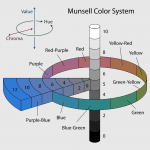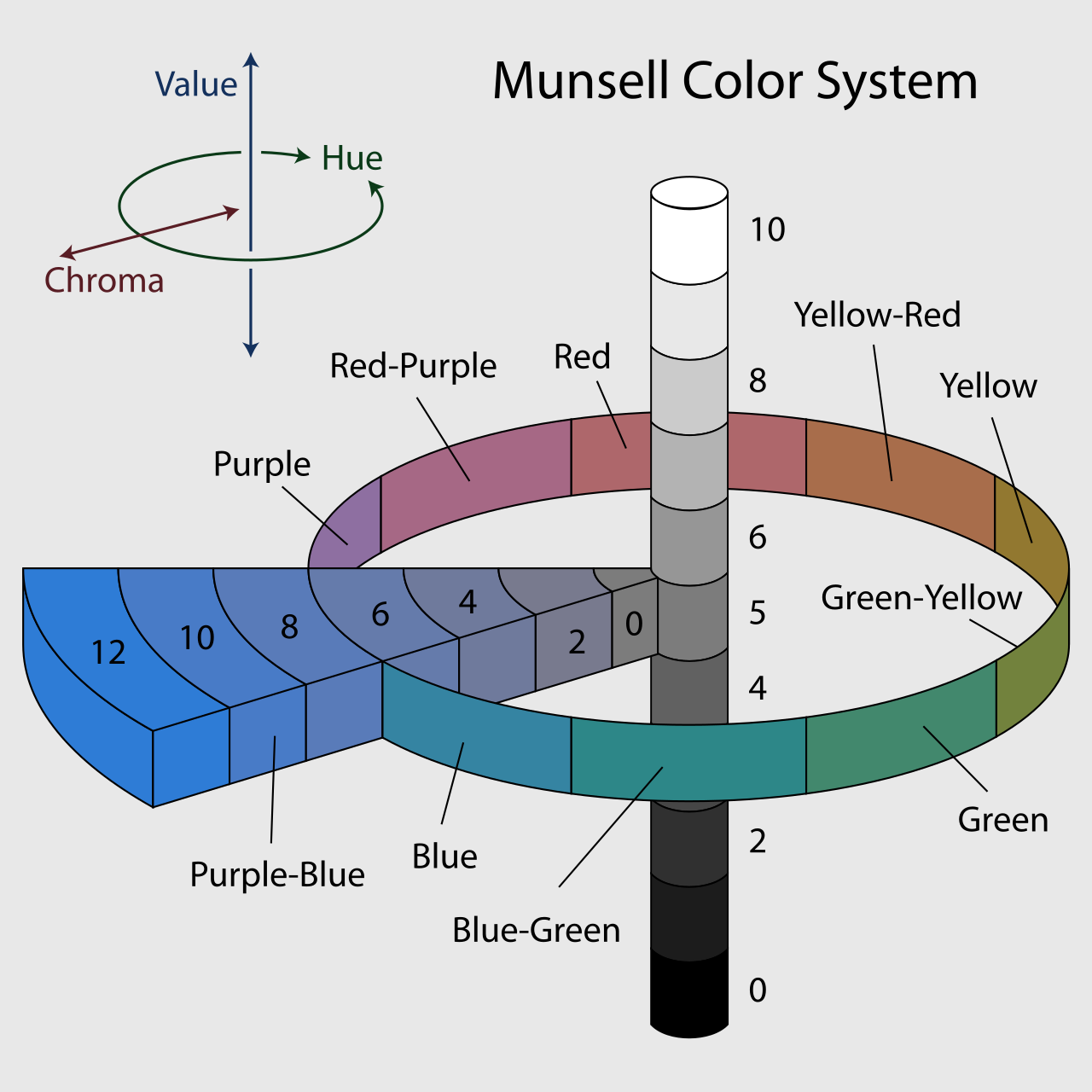(Get free painting tips and plein air painting techniques sent straight to your inbox or on my social media.)
What Is The Munsell Color System

The Munsell color system is a system for organizing color that includes a color wheel to order hues, and a notation system for value and saturation. Values range from 0 (black) to 10 (white). Saturation ranges from 0 (grays) to 14 (pure colors). Therefore, a YR-3-4 represents a dark (value 3) dull (saturation 4) orange, which we usually call brown. A Y-8-12 represents a pure (saturation 12) cadmium yellow, whereas Y-6-6 represents a duller yellow ochre (saturation 6). The Munsell color wheel has ten colors. Its five primary colors are: red, yellow, green, blue, and purple. The five secondary colors are named logically by combining the adjacent two names.
The order of colors in a Munsell color wheel is:
- green-yellow
- yellow
- yellow-red
- red
- red-purple
- purple
- purple-blue
- blue
- blue-green
- green
Tip #1: Number of values 9 or 10?
For simplicity when painting I use 9 values from 1 to 9. This makes it easier to find a half-way value of 5 between black (1) and white (9). You can then divide those values half-way for 3 and 7, and divide those half-way for the rest of the scale. This is much easier than it would be to break the scale down into 10 even steps.
How to remember value notation
Please note that in this course when working with 9 values, we use the number 9 to represent white and 1 to represent black.
A good way to remember the value notation is the more light the bigger the number. 9 is bigger than 5 so it has more light. The smallest light you can have is a 1 – black.
Alternatively some people remember by thinking of candles. A scene is black when there are no candles. The more candles there are, the lighter it is. You need 9 candles to make it white.
The actual values represented will be close enough to the Munsell scale to satisfy our needs in painting. The precision of the Munsell scale is needed more for graphic design use, which most of us don’t need to be so concerned with unless we’re doing graphic posterizations or something that requires precisely matching manufacturers’ design colors.
Tip #2: Munsell Color System and Complements
This wheel was created by Albert H. Munsell and is based on peoples’ visual responses to color. It has more accurate complements for artists. See the lesson titled “What Are Complements?” in the lessons related to Color Unit 01 – Key Concepts. In particular see the assignment about Munsell and triadic comparison of complements.
Tip #3: How To Layout Your Palette
I lay out my palette in the order of the Munsell Color Wheel, going around the color wheel in sequence.

Tip #4: Use the Munsell Color System Notation In Your Sketchbook
The abbreviations for colors in the Munsell color system. Values range from 0 (black) to 10 (white). Saturation ranges from 0 (grays) to 14 (pure colors). Therefore, a YR-3-4 represents a dark (value 3) weak/middle (saturation 4) orange hue, which we usually call brown. This is a quick and convenient way to record colors in your sketch books, when you only have a pencil.
Saturation used in this course
In discussions use the following terminology for levels of saturation. You can use the munsell resources below if you are not sure of the saturation of the color you are talking about.
- neutral 0
- weak 2
- middle 5 6
- high 8
- strong 10 12 14
Munsell Color Charts: The Munsell Book Of Color
If you would like your own copy of the book to play around with and learn color here is how to buy the Munsell Book of Color. (Note this is NOT an affiliate link, in order to maintain our reputation for unbiased and high quality advice and knowledge on painting.)
Munsell Color System Tool
Here is a useful tool for playing around with the Munsell color system and getting to learn the colors.
http://www.andrewwerth.com/color/
For More Information On The Munsell Color System
For more information on the Munsell Color System, see:
Thank You
Thank you for taking the time to read this article. I hope you find it useful. If you would like to get free painting tips by email, please sign up for my free tips newsletter.
If you are interested in a structured approach for learning how to paint, take a look at my online painting classes.
Happy painting!
Barry John Raybould
Virtual Art Academy









Add comment